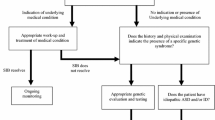Abstract
The endogenous opiate release theory of self-injurious behavior (SIB) was investigated through double-blind placebo-controlled administration of naltrexone hydrochloride (Trexan ®) to a 14-year-old autistic and mentally retarded male for treatment of severe SIB. Results yielded a marked decrease in SIB during two phases of active drug treatment, though SIB did not revert to originally observed placebo levels during a second placebo phase. An increase in social relatedness also was observed during phases of active drug treatment. Opiate theories of self-injury and the possible interrelationship of self-injury with pituitary-adrenal arousal and with social relatedness are discussed.
Similar content being viewed by others
References
Aman, M. G., Singh, N. N., Steward, A. W., & Field, C. J. (1985). The Aberrant Behavior Checklist: A behavior rating scale for the assessment of treatment effects.American Journal of Mental Deficiency, 89, 485–491.
Barrett, R. P. (1986).Severe behavior disorders in the mentally retarded: Nondrug approaches to treatment. New York: Plenum Press.
Barrett, R. P., Feinstein, C., & Hole, W. T. (1989). Effects of naloxone and naltrexone on selfinjury: A double-blind, placebo controlled analysis.American Journal of Mental Retardation, 93, 644–651.
Beckwith, B. E., Couk, D., & Schumaker, K. (1986). Failure of naloxone to reduce self-injurious behavior in two developmentally disabled females.Applied Research in Mental Retardation, 7, 183–188.
Bernstein, G. A., Hughes, J., Mitchell, J. E., & Thompson, T. (1987). Effects of narcotic antagonists on self-injurious behavior: A single case study.Journal of the American Academy of Child and Adolescent Psychiatry, 26, 886–889.
Campbell, M., Adams, P., Small, A., Tesch, L., & Curren, E. (1988). Naltrexone in infantile autism.Psychopharmacology Bulletin, 24, 135–139.
Campbell, M., Overall, J. E., Small, A. M., Sokol, M. S., Spencer, E. K., Adams, P., Foltz, R. L., Monti, K. M., Perry, R., Nobler, M., & Roberts, E. (1989). Naltrexone in autistic children: An acute open dose range tolerance trial.Journal of the American Academy of Child and Adolescent Psychiatry, 28, 200–206.
Carr, E. G. (1977). The motivation of self-injurious behavior: A review of some hypotheses.Psychological Bulletin, 84, 800–816.
Cataldo, M. F., & Harris, J. (1982). The biological basis of self-injury in the mentally retarded.Analysis and Intervention in Developmental Disabilities, 2, 21–39.
Davidson, P. W., Kleene, B. M., Carroll, M., & Rockowitz, R. J. (1983). Effects of naloxone on self-injurious behavior: A case study.Applied Research in Mental Retardation, 4, 1–4.
Deutsch, S. I. (1986). Rationale for the administration of opiate antagonists in treating infantile autism.American Journal of Mental Deficiency, 90, 631–635.
Freeman, B. J., Ritvo, E. R., Yokota, A., & Ritvo, A. (1986). A scale for rating symptoms of patients with autism in real life settings.Journal of the American Academy of Child Psychiatry, 25, 130–136.
Herman, B. H., Hammock, M. K., Arthur-Smith, A., Egan, J., Chatoor, I., Werner, A., & Zelnek, N. (1987). Naltrexone decreases self-injurious behavior.Annals of Neurology, 22, 550–552.
Hill, B. K., Balow, E. A., & Bruininks, R. H. (1985). A national study of prescribed drugs in institutions and community residential facilities for mentally retarded people.Psychopharmacology Bulletin, 21, 279–284.
Kalat, J. (1978). Speculation on the similarities between autism and opiate addiction.Journal of Autism and Childhood Schizophrenia, 8, 477–479.
Panksepp, J. (1979). A neurochemical theory of autism.Trends Neurosciences, 2, 174–177.
Panksepp, J., & Sahley, T. J. (1987). Possible brain opioid involvement in disrupted social intent and language development of autism. In E. Shopler, & G. B. Mesibov (Eds.),Neurobiological issues in autism. New York: Plenum Press.
Panksepp, J., Siviy, S. M., & Normansell, L. A. (1985). Brain opioids and social emotions. In M. Reite & T. Fields (Eds.),The psychobiology of attachment. New York: Academy Press.
Richardson, J. S., & Zaleski, W. A. (1983). Naloxone and self-mutilation.Biological Psychiatry, 18, 99–101.
Sahley, T. L., & Panksepp, J. (1987). Brain opioids and autism: An updated analysis of possible linkages.Journal of Autism and Developmental Disorders, 17, 201–216.
Sandman, C. A., Datta, P. C., Baron, J., Hoehler, F. K., Williams, C., & Swanson, J. M. (1983). Naloxone attenuates self-abusive behavior in developmentally disabled clients.Applied Research in Mental Retardation, 4, 5–11.
Sandyk, R. (1985). Naloxone abolishes self-injuring in a mentally retarded child.Annals of Neurology, 17, 520.
Singh, N. N., & Millichamp, C. J. (1985). Pharmacological treatment of self-injurious behavior in mentally retarded persons.Journal of Autism and Developmental Disorders, 15, 257–267.
Szymanski, L., Kedesky, J., Sulkes, S., Cutler, A., & Stevens-Ours, P. (1987). Naltrexone in treatment of self-injurious behavior: A clinical study.Research in Developmental Disabilities, 8, 179–190.
Author information
Authors and Affiliations
Rights and permissions
About this article
Cite this article
Walters, A.S., Barrett, R.P., Feinstein, C. et al. A case report of naltrexone treatment of self-injury and social withdrawal in autism. J Autism Dev Disord 20, 169–176 (1990). https://doi.org/10.1007/BF02284716
Issue Date:
DOI: https://doi.org/10.1007/BF02284716




